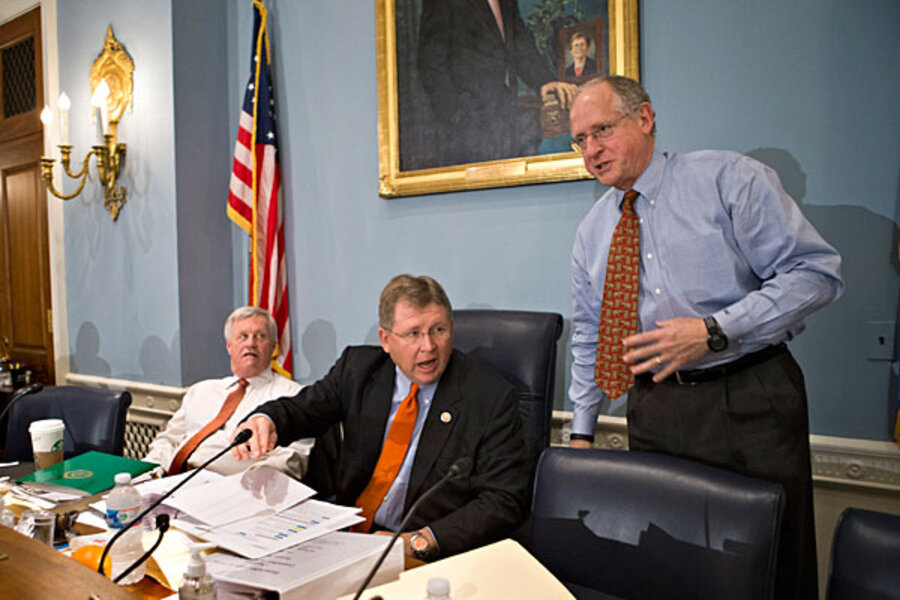House farm bill leaves food stamps in limbo
Loading...
| Washington
House Republicans achieved the elusive goal of passing a farm bill Thursday by slicing federal support for food programs from the bill, breaking a half-century long legislative connection between farm policy and food programs for the poor.
The House GOP's revamp of federal farm policy represents about 20 percent of the cost of the original $1 trillion bill. It passed on a 216-to-208 vote with 12 Republicans joining all 196 Democrats in opposition.
The Republican bill is both narrower in scope and less impactful on the federal deficit than its companion in the Senate – raising questions about how the two chambers will come to an accord on federal farm and food policy before the current farm bill expires at the end of September.
While Democrats bitterly protested the absence of federal nutrition programs for the House bill, there’s little chance nutrition programs will feel much pain.
By shearing the farm bill in half, the House chose to put off the questions of cuts to food stamps, now called the Supplemental Nutrition Assistance Program (SNAP). A previous version of the House farm bill, rejected last month, would have made $20 billion in cuts over the next decade. Instead, House Republicans vow to get to work on a nutrition-only bill that could cut as much as $100 billion from the program, but the legislative prospects for such a proposal are murky.
Without those reductions being passed, the GOP would appear to have little leverage to persuade the Senate to increase the $4 billion in food stamp reductions in its version of the farm bill, says Rep. Colin Peterson (D) of Minnesota, the top Democrat on the House Agriculture Committee. After all, should Congress fail to agree to a deal, the food subsidy programs will continue without any cuts.
But those are fights that Republicans from agricultural areas will be happy to join when the time comes. For now, they’re just relieved to have gotten the farm bill across the finish line.
“We’ll keep rattling sabers when it gets to conference – this is a long battle,” says Rep. Marlin Stutzman (R) of Indiana, who was a key player in the bid to split food assistance programs from the farm bill.
Later, he added: “The House needs to go to conference with the strongest hand, and I think this is the strongest hand we can have.”
The passage was bittersweet for House Agriculture Chairman Frank Lucas (R) of Oklahoma, who worked doggedly to craft a bipartisan farm bill measure in each of the last two Congresses.
In 2012, Republican leaders held a bipartisan farm bill off the House floor. Then last month, a bipartisan bill failed when 60 Republicans revolted against the food programs included in the bill, which they see as bloated, and all but two dozen Democrats withdrew their support over the prospect of some $20 billion in cuts to those food programs.
The final House bill passed Thursday lost its bipartisan support by dealing only with GOP concerns, at the behest of House majority leader Eric Cantor (R) of Virginia.
“I’d like to back this train up if we could – but we can’t,” said Rep. Steve King (R) of Iowa, an agriculture committee member who also favored a bipartisan farm bill.
With no Democrats to be had, House leaders furiously sought votes from their rank-and-file for the measure during the past several days, mustering enough to pass the bill over the opposition of conservative groups like the Club for Growth and the Heritage Foundation.
For House Republicans, the main victory was in divorcing farm policy from food stamps – what some of them dubbed an “unholy alliance” that led to little fiscal scrutiny in either program.
But there was also another sweetener for Republicans buried in the legislation: It repealed permanent farm law from 1938 and 1949.
Those half-century-old laws had remained on the books in order to pressure Congress to reauthorize more modern farm legislation every five years – or else risk sending farm supports back to the Truman Administration.
The House farm bill makes the 2013 law the permanent rule. As such, the subsidies and support programs in place today would continue indefinitely without future farm authorizations.
While lawmakers like Representative Stutzman see the change as a step forward for good government, the move has opponents on both sides.
Democrats like Representative Peterson believe taking away pressure on Congress will allow future farm bills to lapse even longer than the nearly two years that the current measure took to pass the House of Representatives.
Meanwhile, conservative advocacy groups that detest federal supports for agriculture believe that without a sunset, subsidy programs will continue unabated. The bill “seeks to lock in record commodity prices and farm income as the new business as usual farm policy,” wrote Taxpayers for Common Sense in a note to lawmakers.
House leaders have not said whether they would commit to a conference committee to resolve differences between the House bill and the Senate measure, which included food programs and drew support from two-thirds of that chamber last month. But Senate Democrats are clearly ready to get to work.
“We will go to conference with the bipartisan, comprehensive Farm Bill that was passed in the Senate that not only reforms programs, supports families in need and creates agriculture jobs, but also saves billions more than the extremely flawed House bill,” said Sen. Debbie Stabenow (D) of Michigan, the chair of the Senate Agriculture Committee, in a statement.
The Congressional Budget Office said the House bill would reduce the deficit by about $13 billion over the next decade. That’s less than the $18 billion the Senate measure would shave off the deficit over the same time.





